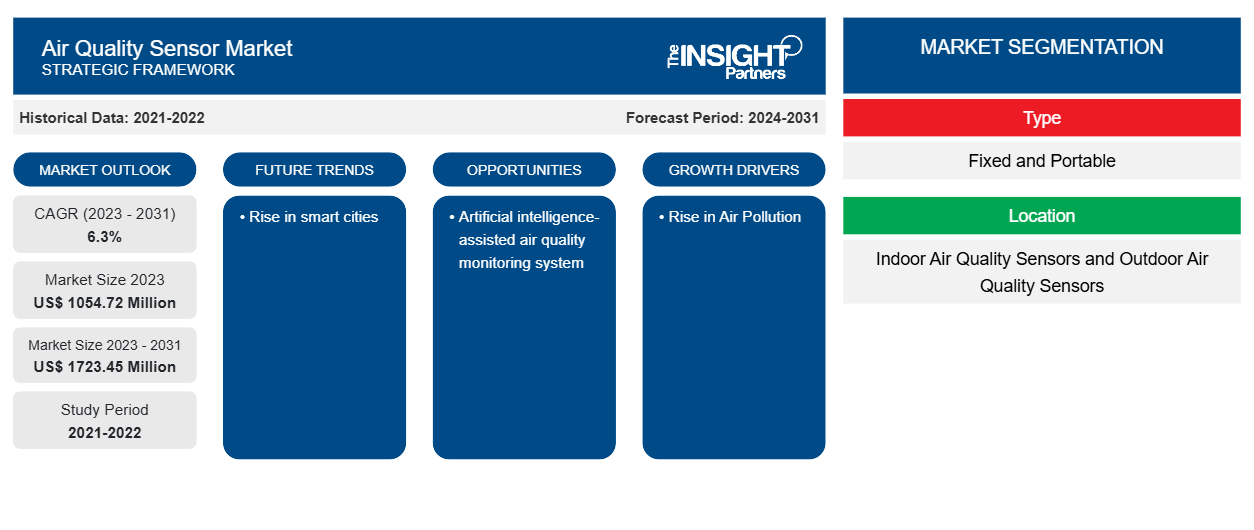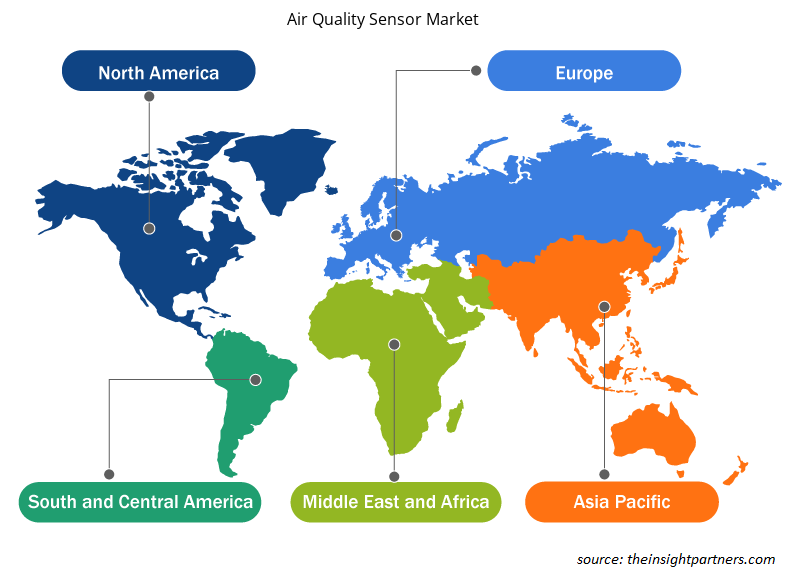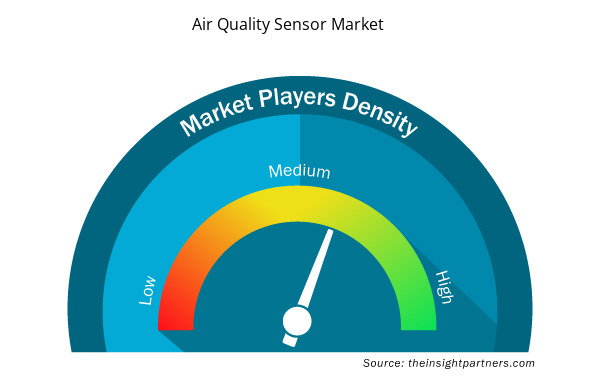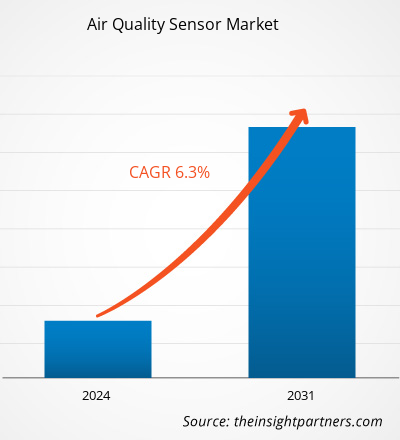The air quality sensor market size is projected to reach US$ 1723.45 million by 2031 from US$ 1054.72 million in 2023. The market is expected to register a CAGR of 6.3% in 2023–2031. Growing air pollution and government focus on sustainability are likely to remain key air quality sensor market trends.
Air Quality Sensor Market Analysis
The growing environmental concerns and stringent regulations by the government to monitor air quality are leading to the adoption of the air quality sensor market. The growing awareness regarding the importance of clean air and the drawbacks of airborne disease fuels its adoption across various industries. Government initiatives towards the development of eco-friendly industries further foster its market growth.
Air Quality Sensor Market Overview
An air quality sensor is a device that measures the concentration of pollutants in the air. It is an essential component of the air purifier and fresh air system. Air quality sensors can usually measure particulate matter (such as pm1, pm2.5, and pm10), gases (such as ozone, carbon monoxide, carbon dioxide, methane, formaldehyde, and others), and some environmental indicators (such as temperature, humidity, UV, illumination, and so on). The air quality sensor detects gas and particulate matter indicators in the air using optical, electrical, thermal, and other methods.
Customize This Report To Suit Your Requirement
You will get customization on any report - free of charge - including parts of this report, or country-level analysis, Excel Data pack, as well as avail great offers and discounts for start-ups & universities
Air Quality Sensor Market: Strategic Insights

- Get Top Key Market Trends of this report.This FREE sample will include data analysis, ranging from market trends to estimates and forecasts.
Customize This Report To Suit Your Requirement
You will get customization on any report - free of charge - including parts of this report, or country-level analysis, Excel Data pack, as well as avail great offers and discounts for start-ups & universities
Air Quality Sensor Market: Strategic Insights

- Get Top Key Market Trends of this report.This FREE sample will include data analysis, ranging from market trends to estimates and forecasts.
Air Quality Sensor Market Drivers and Opportunities
Rise in Air Pollution to Favor Market
Air pollution has increased along with the addition of toxins like particulate matter due to growing industrialization. Governments in several countries have implemented stringent regulations in their respective areas and devised diverse measures to mitigate air pollution originating from industrial sites. In addition, governments in a number of countries, including the US, India, and Canada, install air quality sensors in power plants, oil and gas, and automobiles in order to manage and track pollution levels. By using outdoor air quality monitoring, factories can control their emission rates by keeping an eye on the air quality index around their industrial units.
Benefits of air quality sensors
With the rising environmental concerns worldwide, there is a need to continuously monitor the air quality to take certain actions to minimize its effects on the environment. Therefore, the demand for air quality sensing technologies is gaining traction due to several benefits they offer. It helps to create a healthy environment by monitoring indoor/outdoor air conditions in real-time. The air quality sensors are easy to install and connect easily with the mobile and computer where it display the air quality results. It can detect a wide range of parameters such as temperature, air pressure, humidity, and more. With the continuous technological advancements, the accuracy of these sensors is improving, leading to its demand by several players in wide industries such as government agencies and academic institutes, commercial and residential users, petrochemical industry, power generation plants, pharmaceutical industry, smart city authorities, and others. Thus, to cater to this demand, market players launch solutions that drive the air quality sensor market. For example, in June 2021, Vaisala launched a world-class air quality sensor complementing its monitoring solution to enhance quality of life, safety, efficiency, and sustainability in communities.
Air Quality Sensor Market Report Segmentation Analysis
Key segments that contributed to the derivation of air quality sensor market analysis are type, location, and end user.
- Based on type, the market is segmented into fixed and portable. The fixed airport segment held a larger market share in 2023.
- By location, the market is segmented into indoor air quality sensors and outdoor air quality sensors. The outdoor air quality sensors segment held the largest share of the market in 2023.
- By end user, the market is segmented into government agencies and academic institutes, commercial and residential users, the petrochemical industry, power generation plants, the pharmaceutical industry, smart city authorities, and others. The government agencies and academic institutes segment held the largest share of the market in 2023.
Air Quality Sensor Market Share Analysis by Geography
The geographic scope of the air quality sensor market report is mainly divided into five regions: North America, Asia Pacific, Europe, Middle East & Africa, and South America/South & Central America.
In terms of revenue, Asia Pacific accounted for the largest air quality sensor market share in 2023. The region consists of developed and developing economies such as India, Japan, China, and others, which is driving the demand for these sensors to fuel a clean and safe environment. The rise in awareness regarding the benefits of using these sensors fuels its market growth. In addition, the government bodies in the region are focused on developing these sensors, which foster its market growth further. For example, in January 2023, MeitY launched the Technology for Air Quality Monitoring System (AI-AQMS v1.0) developed under MeitY-supported projects. The Centre for Development of Advanced Computing (C-DAC), Kolkata, in collaboration with TeXMIN, ISM, Dhanbad, under the ‘National Programme on Electronics and ICT applications in Agriculture and Environment (AgriEnIcs)’ developed a outdoor air quality monitoring station to monitor environmental pollutants which include parameters like PM 1.0, PM 2.5, PM 10.0, SO2, NO2, CO, O2, ambient temperature, relative humidity etc., for continuous air quality analysis of the environment.
Air Quality Sensor Market Regional Insights
Air Quality Sensor Market Regional Insights
The regional trends and factors influencing the Air Quality Sensor Market throughout the forecast period have been thoroughly explained by the analysts at Insight Partners. This section also discusses Air Quality Sensor Market segments and geography across North America, Europe, Asia Pacific, Middle East and Africa, and South and Central America.

- Get the Regional Specific Data for Air Quality Sensor Market
Air Quality Sensor Market Report Scope
| Report Attribute | Details |
|---|---|
| Market size in 2023 | US$ 1054.72 Million |
| Market Size by 2031 | US$ 1723.45 Million |
| Global CAGR (2023 - 2031) | 6.3% |
| Historical Data | 2021-2022 |
| Forecast period | 2024-2031 |
| Segments Covered |
By Type
|
| Regions and Countries Covered | North America
|
| Market leaders and key company profiles |
Air Quality Sensor Market Players Density: Understanding Its Impact on Business Dynamics
The Air Quality Sensor Market market is growing rapidly, driven by increasing end-user demand due to factors such as evolving consumer preferences, technological advancements, and greater awareness of the product's benefits. As demand rises, businesses are expanding their offerings, innovating to meet consumer needs, and capitalizing on emerging trends, which further fuels market growth.
Market players density refers to the distribution of firms or companies operating within a particular market or industry. It indicates how many competitors (market players) are present in a given market space relative to its size or total market value.
Major Companies operating in the Air Quality Sensor Market are:
- Energomonitor
- Met One Instruments
- SUEZ
- Renesas Electronics Corporation
- Winsen
- E+E
Disclaimer: The companies listed above are not ranked in any particular order.

- Get the Air Quality Sensor Market top key players overview
Air Quality Sensor Market News and Recent Developments
The Air Quality Sensor Marketis evaluated by gathering qualitative and quantitative data post primary and secondary research, which includes important corporate publications, association data, and databases. The following is a list of developments in the market:
- In March 2024, Vaisala, a global leader in measurement instruments and intelligence for climate action, announced the launch of the Air Quality Transmitter 560 (AQT560), the gold-standard compact air quality sensor with a wide detection range — PM1, PM2.5, and PM10 — and a unique calibration system and algorithms that enable unmatched detection accuracy and efficiency. (Source: Vaisala, Inc, Press Release, 2024)
- In January 2024, Attune, an industry leader in real-time data solutions, introduced its latest innovation with the Outdoor Air Quality (OAQ) Kit, a sensor-based platform designed for monitoring air quality around any given site. Leveraging the UL-2905 Certified indoor air quality monitoring sensors repurposed for outdoor use, the OAQ Kit offers comprehensive data on various outdoor air threats. The multi-sensor, plug-and-play technology detects pollutants such as temperature, relative humidity, volatile organic compounds (VOCs), and particulate matter (PM), providing operators with critical insights for proactive decision-making. (Source: Attune, Press Release, 2024)
Air Quality Sensor Market Report Coverage and Deliverables
The “Air Quality Sensor Market Size and Forecast (2021–2031)” report provides a detailed analysis of the market covering below areas:
- Market size and forecast at global, regional, and country levels for all the key market segments covered under the scope
- Market dynamics such as drivers, restraints, and key opportunities
- Key future trends
- Detailed PEST/Porter’s Five Forces and SWOT analysis
- Global and regional market analysis covering key market trends, major players, regulations, and recent market developments
- Industry landscape and competition analysis covering market concentration, heat map analysis, prominent players, and recent developments
- Detailed company profiles
- Historical Analysis (2 Years), Base Year, Forecast (7 Years) with CAGR
- PEST and SWOT Analysis
- Market Size Value / Volume - Global, Regional, Country
- Industry and Competitive Landscape
- Excel Dataset


- Malaria Treatment Market
- Europe Surety Market
- Environmental Consulting Service Market
- Social Employee Recognition System Market
- Toothpaste Market
- Extracellular Matrix Market
- Green Hydrogen Market
- Visualization and 3D Rendering Software Market
- Small Internal Combustion Engine Market
- Aerosol Paints Market

Report Coverage
Revenue forecast, Company Analysis, Industry landscape, Growth factors, and Trends

Segment Covered
Type ; Location ; and End User

Regional Scope
North America, Europe, Asia Pacific, Middle East & Africa, South & Central America

Country Scope
Argentina, Australia, Brazil, Canada, China, France, Germany, India, Italy, Japan, Mexico, Russian Federation, Saudi Arabia, South Africa, South Korea, United Arab Emirates, United Kingdom, United States
Frequently Asked Questions
The global air quality sensor market was estimated to be US$ 1054.72 million in 2023 and is expected to grow at a CAGR of 6.3% during the forecast period 2023 – 2031.
Growing air pollution and government focus on sustainability are the major factors that propel the global air quality sensor market.
Artificial intelligence-assisted air quality monitoring system is anticipated to play a significant role in the global air quality sensor market in the coming years.
The key players holding majority shares in the global air quality sensor market are Energomonitor, E+E, Infineon Technologies, Siemens AG, and Honeywell International Inc.
The global air quality sensor market is expected to reach US$ 1723.45 million by 2031.
The incremental growth expected to be recorded for the global air quality sensor market during the forecast period is US$ 668.73 million.

 Get Free Sample For
Get Free Sample For